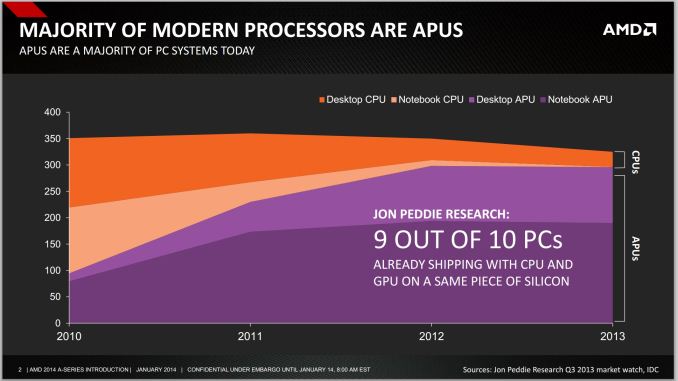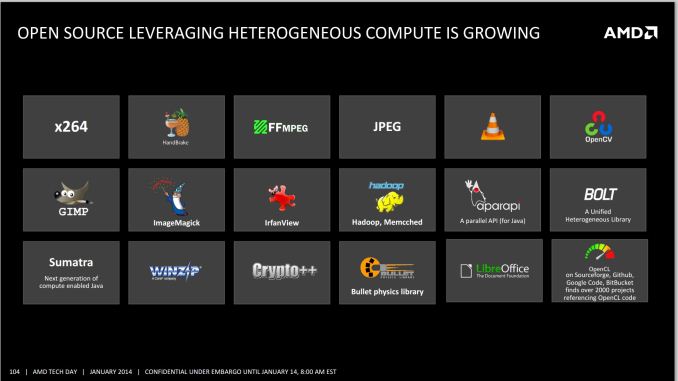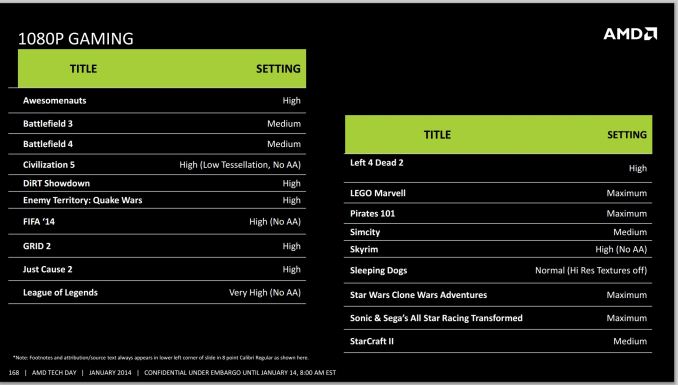AMD Kaveri Review: A8-7600 and A10-7850K Tested
by Ian Cutress & Rahul Garg on January 14, 2014 8:00 AM ESTKaveri: Aiming for 1080p30 and Compute
The numerical differences between Kaveri and Richland are easy enough to rattle off – later in the review we will be discussing these in depth – but at a high level AMD is aiming for a middle ground between the desktop model (CPU + discrete graphics) and Apple’s Mac Pro dream (offloading compute onto different discrete graphics cards) by doing the dream on a single processor. At AMD’s Kaveri tech day the following graph was thrown in front of journalists worldwide:
With Intel now on board, processor graphics is a big deal. You can argue whether or not AMD should continue to use the acronym APU instead of SoC, but the fact remains that it's tough to buy a CPU without an integrated GPU.
In the absence of vertical integration, software optimization always trails hardware availability. If you look at 2011 as the crossover year when APUs/SoCs took over the market, it's not much of a surprise that we haven't seen aggressive moves by software developers to truly leverage GPU compute. Part of the problem has been programming model, which AMD hopes to address with Kaveri and HSA. Kaveri enables a full heterogeneous unified memory architecture (hUMA), such that the integrated graphics topology can access the full breadth of memory that the CPU can, putting a 32GB enabled compute device into the hands of developers.
One of the complexities of compute is also time: getting the CPU and GPU to communicate to each other without HSA and hUMA requires an amount of overhead that is not trivial. For compute, this comes in the form of allowing the CPU and GPU to work on the same data set at the same time, effectively opening up all the compute to the same task without asynchronous calls to memory copies and expensive memory checks for coherency.
The issue AMD has with their HSA ecosystem is the need for developers to jump on board. The analogy oft cited is that on Day 1, iOS had very few apps, yet today has millions. Perhaps a small equivocation fallacy comes in here – Apple is able to manage their OS and system in its entirety, whereas AMD has to compete in the same space as non-HSA enabled products and lacks the control. Nevertheless, AMD is attempting to integrate programming tools for HSA (and OpenCL 2.0) as seamlessly as possible to all modern platforms via a HSA Instruction Layer (HSAIL). The goal is for programming languages like Java, C++ and C++ AMP, as well as common acceleration API libraries and toolkits to provide these features at little or no coding cost. This is something our resident compute guru Rahul will be looking at in further detail later on in the review.
On the gaming side, 30 FPS has been a goal for AMD’s integrated graphics solutions for a couple of generations now.
Arguably we could say that any game should be able to do 30 FPS if we turn down the settings far enough, but AMD has put at least one restriction on that: resolution. 1080p is a lofty goal to hold at 30 FPS with some of the more challenging titles of today. In our testing in this review, it was clear that users had a choice – start with a high resolution and turn the settings down, or keep the settings on medium-high and adjust the resolution. Games like BF4 and Crysis 3 are going to tax any graphics card, especially when additional DirectX 11 features come in to play (ambient occlusion, depth of field, global illumination, and bilateral filtering are some that AMD mention).













380 Comments
View All Comments
extremesheep49 - Friday, February 21, 2014 - link
I don't know if anyone will even see this now but..."The reality is quite clear by now: AMD isn't going to solve its CPU performance issues with anything from the Bulldozer family. What we need is a replacement architecture, one that I suspect we'll get after Excavator concludes the line in 2015."
I don't know that this conclusion is very fair considering this statement if you compare it to a previous article linked below. The linked article recommends a (currently) $100 100W A8-5600K. The Kaveri equivalent is a $120 45W CPU of approximately the same performance.
Doesn't the linked article's recommendations contradict your Kaveri conclusion at least for some cases? Kaveri's CPU performance probably is sufficient for many discrete GPU setups.
http://anandtech.com/show/6934/choosing-a-gaming-c...
Quote from link:
"Recommendations for the Games Tested at 1440p/Max Settings
A CPU for Single GPU Gaming: A8-5600K + Core Parking updates"
Novaguy - Sunday, February 23, 2014 - link
Gaming performance is usually (but not always) GPU bottlenecked, not CPU bottlenecked.The reason why a trinity was getting recommended in a lot of gaming boxes was that in dollar limited scenarios, you'll often get better gaming performance mating a $120 quad core trinity with a $300 gpu, versus a $220 i5 with a $200 gpu.
For even better results, mate an $80 Athlon II X4 750K if you're going discrete gpu, but I don't think the gpu-less trinity chip was available then.
PG - Monday, February 24, 2014 - link
I wanted to compare Kaveri to some other cpus not in this review. Bench would be perfect for that, but the Kaveri cpus are not listed there. Why? Can they be be added?Cptn_Slo - Tuesday, April 1, 2014 - link
Well at least this shows that AMD is able to increase performance significantly given the appropriate die shrink. I'm a big Intel fan but a healthy company/market needs competition, and looks like AMD is able to offer that in at least some areas.zobisch - Wednesday, April 2, 2014 - link
I have an h60 cooler on my 7850k with 2400mhz ram OC'd to 4.4ghz and I love it... I think the corner for APU's will really turn when DDR4 boards come out. I also would like to see an 8core, 24 compute gpu as well but that's probably a die shrink or more away.vickfan104 - Tuesday, May 6, 2014 - link
An Xbox One/PS4-like APU is what I'm still looking for from AMD. To me, that seems like the point where an APU becomes truly compelling as opposed to CPU + discreet GPU.P39Airacobra - Thursday, January 1, 2015 - link
I still can't understand why anyone would be insane enough to pay the outrages high price for a AMD APU simply because it has a built in GPU that can play some games! When for the same price you can get a high end i5 CPU and mid range GPU for a few dollars more! Or for the exact same price you can get a AMD quad and a mid range GPU. Either choice would bloaw any AMD APU out of the water! Yes you can crossfire the APU, But you can also crossfire and SLI regular GPU's. Besides by the time you paid the money for a AMD APU and a GPU to crossfire with it you could have got a nice i3 or FX 6300 or even a last gen IVY i5 with a GPU like a R9 270 or a GTX 660. And either one of those would blow away a APU/Crossfire setup! What are you people thinking? I swear people today would not only buy the Brooklyn bridge once but more than once!P39Airacobra - Thursday, January 1, 2015 - link
Most logical thing to do is buy FX-6300 for $119 and a Motherboard for $60 and then buy a GTX 660 or a R9 270 and buy a 1600x900 resolution monitor and then you will be able to max out anything.P39Airacobra - Thursday, January 1, 2015 - link
Besides 60fps on Medium/High at only 1280x1024 is a laugh! A GT 740 and a R7 250 can do better than that!kzac - Monday, February 16, 2015 - link
After living with the processor on a gigabyte main board for the past several months, I can honestly say its bested both the core i3 and i5 systems (some quad core) I have used in the past. What it might not score on benchmarks for all out throughput it makes up for in its multitasking capability. What normally crashes my i3 and makes my i5 struggle while multitasking (many things open and operating at the same time), doesn’t tend to effect the A10 APU. The core i3 i am using is the later 3220 chip which completely chokes with anything above average multitasking under W7pro, even though it has 12 gig of 1600 ram. The core i5 was better at multitasking than the core i3 but still not near as effective at multitasking as the AMD A10 7850. Where I cannot speak to the performance of the AMD A10 for gaming, for multitasking is very effective.For gaming I have used the FX series AMD processors, both Quad Core and 8 core.